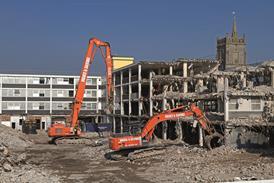Sensitive appreciation and preservation of an area’s history is vital to ensure the longevity and resilience of its regeneration, say Mike Cook and Martyn Saunders at Avison Young UK
The regeneration of our urban spaces is increasingly concentrated on utilising buildings, places and infrastructure to improve people’s lives, through the creation of genuine economic, social and cultural value. Too often this process has focused on wholesale change, at times disregarding an area’s history to create a new vision for the future.
This approach can leave communities feeling disconnected from the places they call home, increasing dissatisfaction and objection to regeneration proposals, and has created homogenised places that lack identity and, as a result, meant places are more vulnerable to economic challenges as residents have little “ownership”.


However, as we begin to grapple more directly with issues of climate change, our own sense of identity and a need to better rethink the role of assets that were once central to civic life but no longer fulfil that role, we are presented with an opportunity to harness the positive role our built heritage can play in creating authentic and vibrant places with which we can all identify.
Why is this important now?
Organisation, consumer and societal changes are leading to a much more significant presence of designated and non-designated heritage assets in our town and city centres that require a new purpose. The key drivers include the restructure of public services, which has meant that a host of buildings that once drove civic identity – town halls, magistrates’ courts, churches, cinemas and others – are now vacant or under-used.
Finding the balance between long-term viable use of these assets and the protection and maintenance of heritage features is a key challenge of our time
Alongside this, change is caused by financial pressures on public agencies who cannot fund maintenance and repair without additional income, as well as changing occupier requirements and consumer preferences which mean equally important banks, post offices and department stores are no longer active.
These high-profile and character-defining assets in our urban centres have a potentially disproportionate impact on the perception of the “health” of those centres. Finding the balance between long-term viable use of these assets and the protection and maintenance of heritage features is a key challenge of our time.
These are more challenging projects than the ‘norm’…
Modernising and repurposing assets entails many complexities, and intervention is often a more costly and slow process. There is a fine balance to be struck between the positive impact gained from heritage assets and the long-term financial sustainability, to ensure the minimum damage is done in creating better environments.
A litany of building conversions show the value in re-using and re-imaging historic buildings, both in terms of the direct outputs and the wider sense of place that is created
These assets not only require specialised designs and the necessary skills and expertise but must also meet modern expectations of building performance and energy efficiency standards. Socially, preserving a sense of community ownership and right of access is integral to success and support from the wider public.
… but the benefits are worth it
Retaining repurposed heritage assets contributes to a genuine and characterful identity in towns and cities, benefiting wider regeneration and development, in a way that connects both the legacy and new communities. If we can find a positive use for heritage assets, then retaining and integrating them with new buildings brings exciting and commercially successful places that deliver what is needed now.
A litany of building conversions show the value in re-using and re-imaging historic buildings, both in terms of the direct outputs and the wider sense of place that is created. Coal Drops Yard in King’s Cross boasts a distinctive identity that drives wider value, and the pivotal role Central St Martin’s has played in attracting office demand are the most obvious and high-profile examples within central London.
International-scale projects often grab the headlines. We have seen success in the restoration and repurposing of old power stations such as the Tate Modern and Battersea Power Station, which have served as anchor points for broader urban revitalisation efforts. These have attracted investment and fostered economic growth in the surrounding areas, creating new jobs through increased tourism, culture and amenity and recreational space.
However, heritage often has a more direct and relevant impact on communities outside of the central city. The Yard in Manchester has evolved over time to play multiple roles.
Originally a school, it has been repurposed to an industrial use, then storage, and now it is being innovatively reanimated as a mixed cultural venue and workspace – supporting the next generation of cultural talent in Manchester while maintaining the city’s roots in the textile trade.
More expansively we have also seen heritage schemes that support local economic development and businesses, in Tunbridge Wells’ Town Hall, the leisure economy via Norwich’s Cosy Club, and the visitor economy such as the proposed redevelopment of Bodlondeb Town Hall as a hotel.
So how do we deliver such a complex and costly task?
The path to success is often fraught with challenges. Many early schemes involving heritage assets have foundered over the decades before the right funding and development mix has succeeded. Heritage assets present the perfect storm of significant restoration costs, listed building restrictions and likely low future rental income.
Patience is key in delivering the necessary balance of economic, social and financial value, but we have to accept that it may cost more upfront and, if the commercial model is well developed, we will reap the rewards in time.
Looking at each asset on a case-by-case, long-term basis that includes broader economic benefits in evaluation is crucial to balance the significant cost and complexity of repurposing a heritage building, with the myriad of benefits it can bring. Grant funding has always been key and wider uses may open access to other funds beyond heritage restoration.
Public or charitable trust-owned assets have funding avenues that are not open to commercial developers
Public-private partnerships can mitigate financial challenges. Public or charitable trust-owned assets have funding avenues that are not open to commercial developers, such as grants from the Heritage Lottery Fund (HLF) or the National Heritage Memorial Fund, which support best-in-class architecture, design and heritage expertise, as well as construction costs.
Public or charitable trust-owned assets such as museums, galleries, theatres, concert halls and the like deliver the culture component and often the visitor footfall, which enhances value when it comes to residential or commercial sales and lettings that reward the development investment. This collaboration between public and private stakeholders can help to leverage existing expertise and resources from both sectors, to maximise impact. Engagement with partners and heritage bodies from an early stage is key to understanding the limitations and opportunities.
It is clear that heritage preservation is increasingly important in contributing to the longevity and resilience of regenerated city districts, but a collaborative and holistic approach needs to be taken to ensure its viability for future generations. We have to understand each building’s potential and, in doing so, how a successful outcome can be achieved.
Mike Cook is director, building and project consultancy, and Martyn Saunders is principal, place, at Avison Young UK


























No comments yet